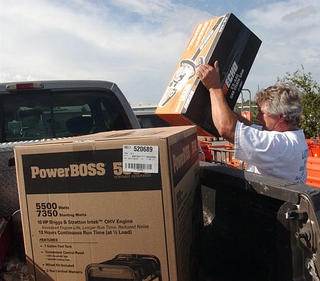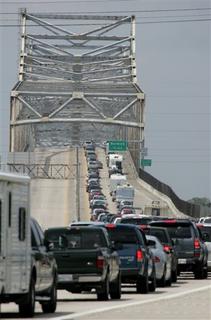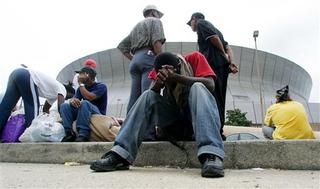KATRINA / New Orleans flees and prays
By ALLEN G. BREED
NEW ORLEANS - (AP) - Monstrous Hurricane Katrina barreled toward the Big Easy on Sunday with 175-mph wind and a threat of a 28-foot storm surge, forcing a mandatory evacuation, a last-ditch Superdome shelter and prayers for those left to face the doomsday scenario this below-sea-level city has long dreaded.
 “Have God on your side, definitely have God on your side,'' Nancy Noble said as she sat with her puppy and three friends in six lanes of one-way traffic on gridlocked Interstate 10. "It's very frightening.''
“Have God on your side, definitely have God on your side,'' Nancy Noble said as she sat with her puppy and three friends in six lanes of one-way traffic on gridlocked Interstate 10. "It's very frightening.''
Katrina intensified into a Category 5 giant over the warm water of the Gulf of Mexico on a path to come ashore early Monday in the heart of New Orleans. That would make it the city's first direct hit in 40 years and the most powerful storm ever to slam the city.
“I'm really scared,'' resident Linda Young said as she fill her gas tank. "I've been through hurricanes, but this one scares me. I think everybody needs to get out.''
Rain began falling on southeastern Louisiana by midday Sunday, the first hints of a storm with a potential surge of 18 to 28 feet, topped with even higher waves, tornadoes and as much as 15 inches of rain.
“We are facing a storm that most of us have long feared,'' Mayor Ray Nagin said in ordering the mandatory evacuation for his city of 485,000 people, surrounded by suburbs of a million more. “The storm surge will most likely topple our levee system.''
ordering the mandatory evacuation for his city of 485,000 people, surrounded by suburbs of a million more. “The storm surge will most likely topple our levee system.''
Conceding that as many as 100,000 inner-city residents didn't have the means to leave and an untold number of tourists were stranded by the closing of the airport, the city arranged buses to take people to 10 last-resort shelters, including the Superdome.
Nagin also dispatched police and firefighters to rouse people out with sirens and bullhorns, and even gave them the authority to commandeer vehicles to aid in the evacuation.
“This is very serious, of the highest nature,'' the mayor said. “This is a once-in-a-lifetime event.''
For years, forecasters have warned of the nightmare scenario a big storm could bring to New Orleans, a bowl of a city that's up to 10 feet below sea level in spots and dependent on a network of levees, canals and pumps to keep dry. It's built between the half-mile-wide Mississippi River and Lake Pontchartrain, half the size of the state of Rhode Island.
Estimates have been made of tens of thousands of deaths from flooding that could overrun the levees and turn New Orleans into a 30-foot-deep toxic lake filled with chemicals and petroleum from refineries, and waste from ruined septic systems.
 Katrina's eye was expected to make landfall around sunrise Monday on the southeastern Louisiana coast, although Mississippi also was in danger, said Ed Rappaport, deputy director of the National Hurricane Center in Miami. Because Katrina was such a big storm with hurricane-force wind of at least 74 mph extending up to 105 miles from the center, areas far from the eye's landfall could still be devastated.
Katrina's eye was expected to make landfall around sunrise Monday on the southeastern Louisiana coast, although Mississippi also was in danger, said Ed Rappaport, deputy director of the National Hurricane Center in Miami. Because Katrina was such a big storm with hurricane-force wind of at least 74 mph extending up to 105 miles from the center, areas far from the eye's landfall could still be devastated.
At 2 p.m. EDT, Katrina's eye was about 180 miles south-southeast of the mouth of the Mississippi River. The storm was moving toward the west-northwest at nearly 13 mph and was expected to turn toward the north-northwest.
A hurricane warning was in effect for the north-central Gulf Coast from Morgan City, La., to the Alabama-Florida line, the hurricane center said. Tropical storm warnings extended east to Indian Pass, Fla., and west to Cameron, La., a spread of about 480 miles.
Despite the dire predictions, a group of residents in a poor neighborhood of central New Orleans sat on a porch with no car, no way out and, surprisingly, no fear.
“We're not evacuating,'' said 57-year-old Julie Paul. “None of us have any place to go. We're counting on the Superdome. That's our lifesaver.''
The Superdome, the 70,000-seat home of football's Saints and the New Year's Sugar Bowl, opened at daybreak Sunday, giving first priority to frail, elderly people on walkers, some with oxygen tanks. They were told to bring enough food, water and medicine to last up to five days.
In the French Quarter, even bars that stayed open through the threat of past hurricanes were boarded up and the few people on the streets were battening down their businesses and getting out.
Don Russina has lived in the city for 20 years and never evacuated for a hurricane, until his wife told him early Sunday that Katrina had been upgraded to Category 5. “This is the first one that's been a direct hit. When the boss says 'no' I've got to go,'' he said as he took down the hanging signs from his Irish-themed gift shop.
Airport Holiday Inn manager Joyce Tillis spent the morning calling her 140 guests to tell them about the evacuation order. Tillis, who lives inside the flood zone, also called her three daughters to tell them to get out.
“If I'm stuck, I'm stuck,'' Tillis said. îîI'd rather save my second generation if I can.''
But the evacuation was slow going. Highways in Louisiana and Mississippi were jammed as people headed away from Katrina's expected landfall. All lanes were limited to northbound traffic on Interstates 55 and 59, and westbound on I-10.
Katrina was îîunmitigated bad news'' for motorists across the nation because it shut down offshore production of at least 1 million barrels of oil daily and threatened refinery and import operations around New Orleans, said oil analyst Peter Beutel. He predicted crude oil could top $70 a barrel by Monday or Tuesday.
Hotels were spared from evacuation orders to give tourists and locals a place for “vertical evacuation.''
for “vertical evacuation.''
Tina and Bryan Steven, a couple from Forest Lake, Minn., who came to attend a conference of emergency medical services, sat glumly on the sidewalk outside their hotel in the French Quarter.
“We're choosing the best of two evils,'' said Bryan Steven. “It's either be stuck in the hotel or stuck on the road. ... We'll make it through it.''
His wife, wearing a Bourbon Street T-shirt with a lewd message, interjected: îîI just don't want to die in this shirt.''
Only three Category 5 hurricanes … the highest on the Saffir-Simpson scale … have hit the United States since record-keeping began. The last was 1992's Hurricane Andrew, which at 145-mph leveled parts of South Florida, killed 43 people and caused $31 billion in damage.
New Orleans has not taken a major direct hit from a hurricane since Betsy in 1965, when an 8- to 10-foot storm surge submerged parts of the city in seven feet of water. Betsy, a Category 3 storm, was blamed for 74 deaths in Louisiana, Mississippi and Florida.
Rappaport warned that Katrina, already responsible for nine deaths in South Florida as a mere Category 1, could be far worse for New Orleans.
“It would be the strongest we've had in recorded history there,'' Rappaport said. “We're hoping of course there'll be a slight tapering off at least of the winds, but we can't plan on that. ... We're in for some trouble here no matter what.''
NEW ORLEANS - (AP) - Monstrous Hurricane Katrina barreled toward the Big Easy on Sunday with 175-mph wind and a threat of a 28-foot storm surge, forcing a mandatory evacuation, a last-ditch Superdome shelter and prayers for those left to face the doomsday scenario this below-sea-level city has long dreaded.
 “Have God on your side, definitely have God on your side,'' Nancy Noble said as she sat with her puppy and three friends in six lanes of one-way traffic on gridlocked Interstate 10. "It's very frightening.''
“Have God on your side, definitely have God on your side,'' Nancy Noble said as she sat with her puppy and three friends in six lanes of one-way traffic on gridlocked Interstate 10. "It's very frightening.''Katrina intensified into a Category 5 giant over the warm water of the Gulf of Mexico on a path to come ashore early Monday in the heart of New Orleans. That would make it the city's first direct hit in 40 years and the most powerful storm ever to slam the city.
“I'm really scared,'' resident Linda Young said as she fill her gas tank. "I've been through hurricanes, but this one scares me. I think everybody needs to get out.''
Rain began falling on southeastern Louisiana by midday Sunday, the first hints of a storm with a potential surge of 18 to 28 feet, topped with even higher waves, tornadoes and as much as 15 inches of rain.
“We are facing a storm that most of us have long feared,'' Mayor Ray Nagin said in
 ordering the mandatory evacuation for his city of 485,000 people, surrounded by suburbs of a million more. “The storm surge will most likely topple our levee system.''
ordering the mandatory evacuation for his city of 485,000 people, surrounded by suburbs of a million more. “The storm surge will most likely topple our levee system.''Conceding that as many as 100,000 inner-city residents didn't have the means to leave and an untold number of tourists were stranded by the closing of the airport, the city arranged buses to take people to 10 last-resort shelters, including the Superdome.
Nagin also dispatched police and firefighters to rouse people out with sirens and bullhorns, and even gave them the authority to commandeer vehicles to aid in the evacuation.
“This is very serious, of the highest nature,'' the mayor said. “This is a once-in-a-lifetime event.''
For years, forecasters have warned of the nightmare scenario a big storm could bring to New Orleans, a bowl of a city that's up to 10 feet below sea level in spots and dependent on a network of levees, canals and pumps to keep dry. It's built between the half-mile-wide Mississippi River and Lake Pontchartrain, half the size of the state of Rhode Island.
Estimates have been made of tens of thousands of deaths from flooding that could overrun the levees and turn New Orleans into a 30-foot-deep toxic lake filled with chemicals and petroleum from refineries, and waste from ruined septic systems.
 Katrina's eye was expected to make landfall around sunrise Monday on the southeastern Louisiana coast, although Mississippi also was in danger, said Ed Rappaport, deputy director of the National Hurricane Center in Miami. Because Katrina was such a big storm with hurricane-force wind of at least 74 mph extending up to 105 miles from the center, areas far from the eye's landfall could still be devastated.
Katrina's eye was expected to make landfall around sunrise Monday on the southeastern Louisiana coast, although Mississippi also was in danger, said Ed Rappaport, deputy director of the National Hurricane Center in Miami. Because Katrina was such a big storm with hurricane-force wind of at least 74 mph extending up to 105 miles from the center, areas far from the eye's landfall could still be devastated.At 2 p.m. EDT, Katrina's eye was about 180 miles south-southeast of the mouth of the Mississippi River. The storm was moving toward the west-northwest at nearly 13 mph and was expected to turn toward the north-northwest.
A hurricane warning was in effect for the north-central Gulf Coast from Morgan City, La., to the Alabama-Florida line, the hurricane center said. Tropical storm warnings extended east to Indian Pass, Fla., and west to Cameron, La., a spread of about 480 miles.
Despite the dire predictions, a group of residents in a poor neighborhood of central New Orleans sat on a porch with no car, no way out and, surprisingly, no fear.
“We're not evacuating,'' said 57-year-old Julie Paul. “None of us have any place to go. We're counting on the Superdome. That's our lifesaver.''
The Superdome, the 70,000-seat home of football's Saints and the New Year's Sugar Bowl, opened at daybreak Sunday, giving first priority to frail, elderly people on walkers, some with oxygen tanks. They were told to bring enough food, water and medicine to last up to five days.
In the French Quarter, even bars that stayed open through the threat of past hurricanes were boarded up and the few people on the streets were battening down their businesses and getting out.
Don Russina has lived in the city for 20 years and never evacuated for a hurricane, until his wife told him early Sunday that Katrina had been upgraded to Category 5. “This is the first one that's been a direct hit. When the boss says 'no' I've got to go,'' he said as he took down the hanging signs from his Irish-themed gift shop.
Airport Holiday Inn manager Joyce Tillis spent the morning calling her 140 guests to tell them about the evacuation order. Tillis, who lives inside the flood zone, also called her three daughters to tell them to get out.
“If I'm stuck, I'm stuck,'' Tillis said. îîI'd rather save my second generation if I can.''
But the evacuation was slow going. Highways in Louisiana and Mississippi were jammed as people headed away from Katrina's expected landfall. All lanes were limited to northbound traffic on Interstates 55 and 59, and westbound on I-10.
Katrina was îîunmitigated bad news'' for motorists across the nation because it shut down offshore production of at least 1 million barrels of oil daily and threatened refinery and import operations around New Orleans, said oil analyst Peter Beutel. He predicted crude oil could top $70 a barrel by Monday or Tuesday.
Hotels were spared from evacuation orders to give tourists and locals a place
 for “vertical evacuation.''
for “vertical evacuation.''Tina and Bryan Steven, a couple from Forest Lake, Minn., who came to attend a conference of emergency medical services, sat glumly on the sidewalk outside their hotel in the French Quarter.
“We're choosing the best of two evils,'' said Bryan Steven. “It's either be stuck in the hotel or stuck on the road. ... We'll make it through it.''
His wife, wearing a Bourbon Street T-shirt with a lewd message, interjected: îîI just don't want to die in this shirt.''
Only three Category 5 hurricanes … the highest on the Saffir-Simpson scale … have hit the United States since record-keeping began. The last was 1992's Hurricane Andrew, which at 145-mph leveled parts of South Florida, killed 43 people and caused $31 billion in damage.
New Orleans has not taken a major direct hit from a hurricane since Betsy in 1965, when an 8- to 10-foot storm surge submerged parts of the city in seven feet of water. Betsy, a Category 3 storm, was blamed for 74 deaths in Louisiana, Mississippi and Florida.
Rappaport warned that Katrina, already responsible for nine deaths in South Florida as a mere Category 1, could be far worse for New Orleans.
“It would be the strongest we've had in recorded history there,'' Rappaport said. “We're hoping of course there'll be a slight tapering off at least of the winds, but we can't plan on that. ... We're in for some trouble here no matter what.''

<< Home